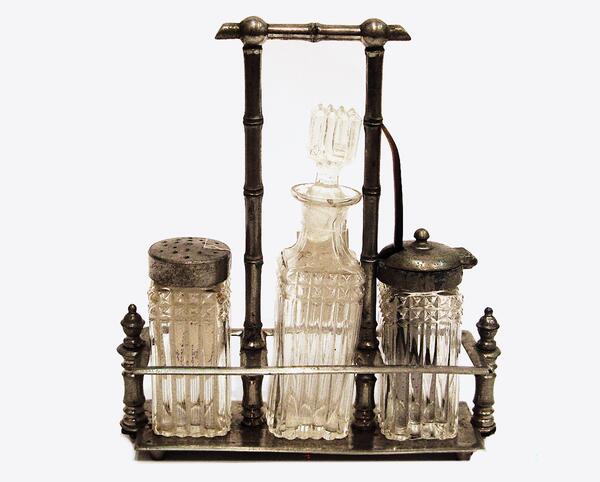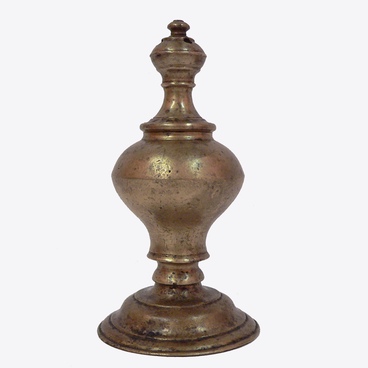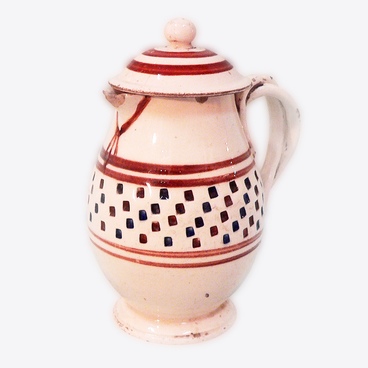Made in the 1930s, this display consists of a stand, three glass spice jars and a spoon. The set belonged to the Kovrigín family - Zosíma Alekséevich and Anna Grigórievna. Zosíma Kovrigín were born in the village of Grikhnevó, Solvychevódsky district (now - Kotlássky district), and worked on the railway.
The salt shaker is a rectangular glass container with embossed sides and has a threaded metal lid with perforation. The upper part is cut in the form of squares.
The rectangular bottle for vinegar or vegetable oil is made of colorless transparent glass, the elongated neck is equipped with a square-shaped ground stopper. In the upper part of the bottle there is a square cut.
The shaker for pepper or mustard also has a rectangular shape with embossed sides and a threaded metal lid with a side hole for a spoon. In the upper part there is a similar cutting in the form of squares.
The mustard spoon is made of bone in the shape of a shoulder blade, with an oval-shaped scoop and a flat long curved handle.
Spice holders are a unique creation. They are small vessels for storing and serving salt, pepper, mustard and other spices. The most common are salt shakers — they are created from a variety of materials.
Until the middle of the 19th century, the word ‘salt shaker’ was usually used to refer to boxes for storing salt and spices, and there were no special holes in the lids. The prototype of the modern salt shaker with holes was a container developed by the American tinsmith John Landis Mason in 1858. The modern-looking salt shakers that prevent their contents from caking began to be produced in the 1920s by the American company Morton Salt. Such salt shakers became especially popular in the 1930s, when global ceramic manufacturers focused on producing inexpensive goods.
Now you can buy both ordinary salt shakers and salt shakers which are works of art — made from expensive materials, richly decorated or painted, or in an atypical shape: for example, in the form of an animal or a funny creature.
The salt shaker is a rectangular glass container with embossed sides and has a threaded metal lid with perforation. The upper part is cut in the form of squares.
The rectangular bottle for vinegar or vegetable oil is made of colorless transparent glass, the elongated neck is equipped with a square-shaped ground stopper. In the upper part of the bottle there is a square cut.
The shaker for pepper or mustard also has a rectangular shape with embossed sides and a threaded metal lid with a side hole for a spoon. In the upper part there is a similar cutting in the form of squares.
The mustard spoon is made of bone in the shape of a shoulder blade, with an oval-shaped scoop and a flat long curved handle.
Spice holders are a unique creation. They are small vessels for storing and serving salt, pepper, mustard and other spices. The most common are salt shakers — they are created from a variety of materials.
Until the middle of the 19th century, the word ‘salt shaker’ was usually used to refer to boxes for storing salt and spices, and there were no special holes in the lids. The prototype of the modern salt shaker with holes was a container developed by the American tinsmith John Landis Mason in 1858. The modern-looking salt shakers that prevent their contents from caking began to be produced in the 1920s by the American company Morton Salt. Such salt shakers became especially popular in the 1930s, when global ceramic manufacturers focused on producing inexpensive goods.
Now you can buy both ordinary salt shakers and salt shakers which are works of art — made from expensive materials, richly decorated or painted, or in an atypical shape: for example, in the form of an animal or a funny creature.



